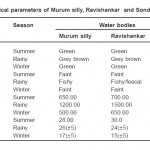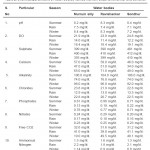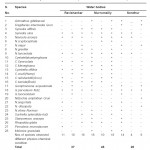Impact of Physico-Chemical Parameters on Microbial Diversity: Seasonal Study
Mangla Raibole1 * and Y.P. Singh2
1
Department of Zoology,
(DESM) Regional Institute of Education (NCERT),
Shyamla Hills,
Bhopal,
India
2
Shyamla Hills,
Bhopal,
India
DOI: http://dx.doi.org/10.12944/CWE.6.1.09
Water is the most precious resource on earth. It plays a predominant role in distribution of organisms. Fresh water contains various micro-organisms6. The quality of water1,5 through parameters (Physico-Chemical) affects the species composition, their abundance and productivity of water. Some organisms can survive in a wide range of conditions and some are more tolerant to pollution while others are very sensitive to changes in conditions and intolerant to pollution. These fresh water bodies namely Ravishankar, Murrum-silly and Sondhur reservoir, which serve as drinking, irrigation and major Sources of fish culture were studied with relation in between physico-chemical condition and diatoms flora. Samples were collected on the monthly basis from three selected sites of water bodies for a period of one year. Author carried out the 28 species of diatoms have been recorded minimum species were recorded in Sondhur reservoir and maximum species are recorded in Ravishankar reservoir. The number of species diatoms were directly affected to physico-chemical condition of concern water bodies. In this study, reported, diatoms species grow better during January to April and November to December and pH range of 7.8 to 8.6. Similarly high nitrate and phosphate content and dissolved oxygen favour more growth of all the species. The role of physico-chemical parameters in productivity of diatoms has been discussed in this research.
Copy the following to cite this article:
Raibole M, Singh Y.P. Impact of Physico-Chemical Parameters on Microbial Diversity: Seasonal Study. Curr World Environ 2011:6(1);71-76. DOI:http://dx.doi.org/10.12944/CWE.6.1.09
Copy the following to cite this URL:
Raibole M, Singh Y.P. Impact of Physico-Chemical Parameters on Microbial Diversity: Seasonal Study. Curr World Environ 2011:6(1);71-76. Available from: http://www.cwejournal.org/?p=1279
Download article (pdf) Citation Manager Publish History
Select type of program for download
| Endnote EndNote format (Mac & Win) | |
| Reference Manager Ris format (Win only) | |
| Procite Ris format (Win only) | |
| Medlars Format | |
| RefWorks Format RefWorks format (Mac & Win) | |
| BibTex Format BibTex format (Mac & Win) |
Article Publishing History
| Received: | 2011-02-07 |
|---|---|
| Accepted: | 2011-03-15 |
Introduction
Fresh water contains various micro-organism. The quality (physico-chemical) of water affects to species composition, abundance and productivity of water. Physical and chemical parameters are directly related to micro-organisms and productivity of water bodies. Some organism can survive in a wide range of condition and some are more tolerant to pollution and other are very sensitive to change in conditions and are intolerant to pollution. Generally a large number of flora (algae) are natural food source of economically importance, fauna like fishes and their presence, play a significant role in the productivity of water bodies.
Authors selected three fresh water bodies namely Murum-silly, Ravishanker, Sondhur reservoir, which is major source of drinking, irrigation and fish culture were studied with relation in between physico-chemical parameters and diatom flora.
Material and Methods
These water bodies are situated in the Dhamtari (C.G.) region, which is situated in mid and mid-eastern part of India. (longitude=8.1E and latitude=22.9 N.). These water bodies are situated approximately from Dhamtari Distt.
- Murum-silly about 29 Km away
- Ravishanker about 11 Km away
- Sondhur Reservoir about 70 Km away
Sample were collected on the monthly basis from three selected site of water bodies for a period of one year. Dhamtari region is tropical area. There is rainy season from 15 June to 15 October, Winter season from Nov. to Feb and Summer season from March to June. The maximum temperature is between 34 - 44 ± 2oC and minimum 6-12 ± 2°C.
Collection of Sample
Site l This site is surrounded by agricultural fields.
Site II This site is an entry point of human and animals inhabitants.
Site III In this site not any activity of animal and human being, is found.
For investigation, algae, water and mud sample were collected from selected site in sterilized sampling bottles. Sample were preserved in 5% formalin for identification of algae using keys provided by Gonazalves and Joshi, 1946 Prescott 1957, Tiffany and Britton 1952, and Desikachary4 1959, Jenson 1985, Kobayasi 1968 and Sarode and Kamat 1984.
Sample for diatoms and algae were collected from these water bodies by scrubbing the surface of the submerged substratum rocks etc.
For estimation of dissolved oxygen, water was collected in B.O.D bottles and fixed at the sampling spot. Water sample were collected at 6:30 to 9:00 a.m.
The Diatoms were processed according to “Burn’s Method” by treating them with hydrochloric acid, for 24 hours followed by treatment with sulphuric acid to which a few crystals of potassium dichromate were added.
Samples for physico-chemical analysis of water was carried out regularly in the first week of every month. In this study, four physical and seven chemical parameters were taken. The water analysis was carried out by the APHA (standard method for the examination of waste water 18th edition.) 1989 and 1992.
Results and Discussion
Authors reported diatoms species (Table-3) grow better during January to April and November to December and high pH 7.8 to 8.6 value are favourable. Some nutrients like nitrate and organo-phosphate are also helps in growth and development of flora and diatoms species. Physical parameters (Table-1) and chemical parameters (Table-2) and their values play a significant role for the productivity of water bodies for their betterment (economically important).
 |
Table 1: Physical parameters of Murum silly, Ravishankar and Sondhur Reservoir Click here to View table |
In this research, selected three reservoirs whose sampling were done in three sites and Grab method helped in diatoms and algae were collected. Sampling is done on monthly basis.
In this research 28 species of diatoms have been recorded. The no. of diatoms species are found in Ravishankar reservoir 37 was more compared to Murum silly reservoir 46 and Sondhur reservoir 26. Diatoms were directly affected by physico-chemical conditions of concerned water bodies.
Diatoms and flora are also affected by high temperature. Diatoms species grow better during moderate temperature of water, presence of nutrients (nitrate and organo phosphate), dissolved oxygen concentration and colder months are also favourable for multiplication of diatoms species. Diatoms species and flora are more effected from organic matter of water.
 |
Table 2: Chemical parameters of water bodies named Murrum silly, Ravishankar and Sondhur Click here to View table |
 |
Table 3: Physico-chemical variations (Seasonal variation in some flora) Click here to View table |
Conclusion
This research, concluded that water play a significant role for living organism. It is observed that, a minute variation in water quality some diatoms can tolerate and other perishes (died).
Presence of nutrients, in water like nitrate and organo-phosphate help in growth and development and also helps in multiplication of productivity.
In this study samples were collected samples from three different sources. These sources (reservoir) are situated in Dhamtari dist. of Raipur we analyze four physical and seven chemical parameters by APHA (Standard Method for the examination of water and waste water 18thedition) Diatoms and flora are collected by Grab method.
References
- A.P.H.A., Standard Method for the examination of water and waste water 18th and A.P.H.A. Washington 1 : 2 (1989 and 1992)
- Ashok P. prabu,V.P. perumal and M.rajkumar., Diversity of microzooplankton in Parangipettai coastal waters,South east cost of India. J. mar. boil. Ass. India, 47(1): 14-19 (2005).
- Biswas, K., Common diatoms of Loktak Lake, Manipur, Assam, Jour, Royal Asiatic Society Ben. 2: 171-175 (1936).
- Borhate, V.P. and Tarar J.L., Additional to algal flora of Maharastra. Diatoms from Khandesh Phytos. 22: 13-17 (1983).
- Desikachary, T.V., Cyanophyta, New Delhi : ICAR. P.P. I - 686 (1959).
- Godhantaram,N.and Uye, Geographical and seasonal variations in taxonomic composition, abudance and biomass of microzooplankton across a brackish –water lagoonal system of Japan. J.Plankton Res. 25: 465-482 (2003).
- Godhantaraman, N., Seasonal variation in species composition, abundance, biomass and estimated production rates of Tintinnids at tropical esturine and mangrove waters, Parangipettai, Southeast coast of India. J.mar.sys, 36: 161-171 (2002).
- Goswami. S.C. and Padmavathi, Zooplankton production composition and diversity in the coastal waters of Goa. Indian J.mar sci., 25; 91-97 (1996)
- Govindasamy,C.,L. Kannan and Azariah, J., Seasonal variation in physico-chemical properties and primary production in the coastal water biotopes of Coromandel Coast, India. J. Environ. Biol. 21(1): 1-7 (2000).
- Hiriart, M.M., Vidal, Y.L., Leon, S.P.-de, Calva, J.J., Callejas, F.R. and rojos, G.C., Longitudinal Study of Microbial diversity & seasonality in the Mexico city metro polition area water supply system. 71(a): 5129-5137 (2005).
- Karuppasamy,P.K.and P.K. and P.Perumal., Biodiversity of zooplankton at Pichavaram mangroves south India. Avan.Biosci, 19: 23-32 (2000).
- Madhupratap,M.and Takashi Onbe., Structure and species diversity the zooplankton community of the Island sea of Japan.Est.coastal and shelf sci, 89: 1-2 (1986).
- Maruthanayagam,C. and Subramanian., Biochemical variation of zooplankton population. J.Mar.Biol.Ass.India. 41: 111-115 (1999).
- Padmavathi,G.and Goswami,S.C and G.Padmavathi., Zooplankton ecology in the Mandovizuari estuarine system of Goa,west coast of India.Indian J.mar.sci, 25: 268-273 (1996).
- Palmer, M.A., Biodiversity and ecosystem process in fresh water sediments. 26(8): 571-577 (1997).
- Rajkumar, M. Perumal,P.,Ganesan,S. and Sundaram, M.S., Species composition and diversity of zooplankton in the Pichavaram mangroves,South east coast of India. Aquatic ecology. 85-114 (2009).
- Sampathkumar, P.and Khannan., Seasonal variation in physico-chemical characteristics in the Tranquebar-Naga pattinam region, South east coast of India. Poll.Res.17(40): 397-402 (1998).
- Santhanam, P and Perumal.P., Diversity of zooplankton in Parangipettai coastal waters, South east coast of India. J.mar. boil. ass. India, 45(2): 144-151 (2003).
- Sood, A., Singh, K.D., Pandey, P. and Sharma, S., Assessment of bacterial indicators and physicochemical parameters to investigate pollution status of Gangetic river system of Uttarakhand (India). 8(5): 709-717 (2008).
- Strickland,j.d.h.and Parsons, A practical hand book of sea water analysis. Bull.Fish. Res. Bd. Canada, 167: 310 (1972).







